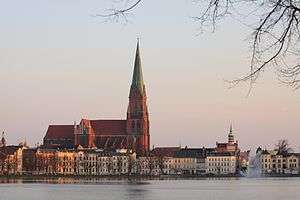Schwerin Cathedral



Schwerin Cathedral (German: Schweriner Dom) was formerly a Roman Catholic cathedral as old as the city itself, dedicated to the Virgin Mary and Saint John. It was built in Schwerin, North Germany, following the move here of the seat of the Bishopric of the Abodrites, established by Henry the Lion, from the old city of Mecklenburg in the late 12th century. The first cathedral was built of timber. The foundation stone of the stone cathedral of the Prince-Bishopric of Schwerin was laid in 1172. After a construction period of seventy-six years, it was consecrated in 1248. The proto-cathedral is now the church of the Bishop of the Evangelical Lutheran State Church of Mecklenburg.
In 1222 Count Henry of Schwerin returned from a crusade with a reliquary of the Holy Blood, an alleged drop of Christ's blood contained in a jewel. This was placed in the cathedral, and caused it to become a place of pilgrimage.
A number of great churches served as models for Schwerin Cathedral: St. Mary's Church in Lübeck, the Nikolaikirche in Stralsund and the cathedral of Ratzeburg.
During the 14th century the nave and transept were completed, as well as the chapter buildings. At the end of the 15th century the cloister on the north side was finished.
The tower, 117.5 metres high, was constructed between 1889 and 1893.
| Wikimedia Commons has media related to Schweriner Dom. |
Coordinates: 53°37′47″N 11°24′53″E / 53.62972°N 11.41472°E